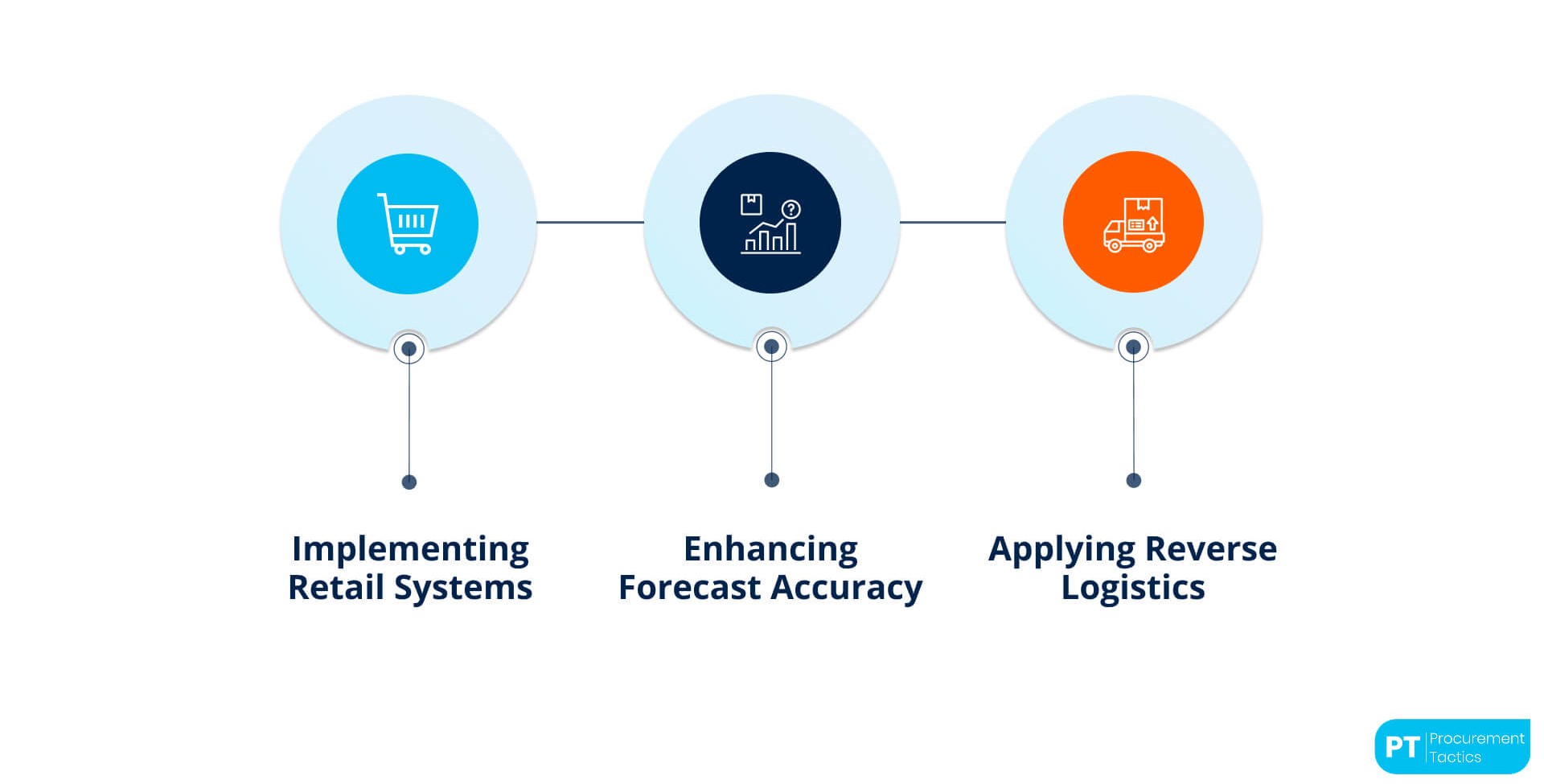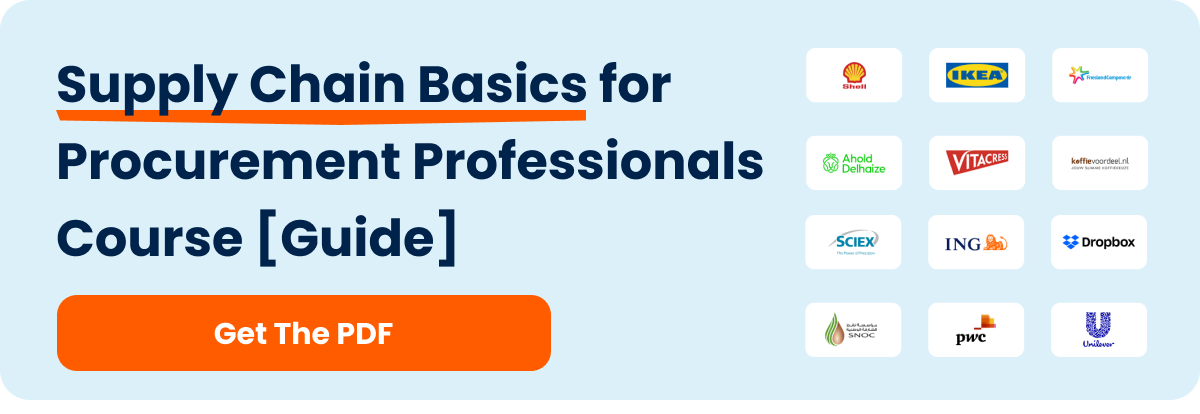Written by Marijn Overvest | Reviewed by Sjoerd Goedhart | Fact Checked by Ruud Emonds | Our editorial policy
Retail Supply Chain Management — Definition + Examples
Table of contents
- What is Retail Supply Chain Management?
- Examples of Retail Supply Chain Management
- My Experience in Retail Supply Chain
- Retail Supply Chain Process Flow
- Challenges
- How to Improve Retail Supply Chain Management
- Trends in Retail Supply Chain
- Importance of Retail Supply Chain Management
- Conclusion
- Frequently asked questions
What is retail supply chain management?
- The retail supply chain is the flow of processes that involves the production and distribution of a company’s products.
- Retail supply chain management emphasizes efficiency and cost-effectiveness in logistics operations starting from raw material procurement to customer delivery.
- The significance of retail supply chain management is highlighted by consumer expectations of fast delivery and free shipping among others.
What is Retail Supply Chain Management?
Retail supply chain management ensures that the logistics operations of a business are optimized throughout the supply chain, from obtaining raw materials to delivering them to customers in the product cycle.
Additionally, it refers to how managers handle inbound and outbound logistics of goods. Supply chain managers optimize supply-side processes to cut costs, deliver products faster, and gain a competitive advantage in the market against other businesses.
Through retail supply chain management, processes are streamlined to maximize speed and efficiency. You need to deliver the products to your customers quickly to satisfy them. However, you do not want to pay too much only to do that. Thus, optimizing your processes is the key to being cost-efficient in managing them.
Examples of Retail Supply Chain Management
1. Walmart – hyper-automated big-box logistics
Over the past two years, Walmart has rebuilt the backbone of its U.S. network around next-generation fulfillment and distribution centers where pallet-to-pallet robots, AI-driven slotting algorithms, and computer-vision drones now handle as much as 65 % of unit volume.
Predictive analytics pulls sell-through data every 30 minutes to trigger vendor-managed inventory replenishment, while the retailer’s new AI Route Optimization suite continuously re-plans outbound loads to shave empty miles and CO₂.
Together, the automation layer and data-sharing with suppliers have cut per-unit handling costs by almost one-third and kept shelf availability above 95 % even during the 2024 holiday surge.
2. Zara (Inditex) – the 15-day fast-fashion clock
Zara’s supply chain is built for speed rather than lowest cost: roughly half of its garments are cut and sewn in company-owned factories in Spain and Portugal, only 36 – 40 hours by truck from its global distribution hub in Arteixo.
Twice a week, every store’s POS system sends real-time sell-through and style feedback to the headquarters design studio; within hours, new patterns are released to local plants, and finished items reach European stores in as little as 48 hours (10-14 days for the rest of the world).
This vertically integrated, near-shored model lets Zara refresh collections 20-24 times a year—far more often than traditional apparel chains—while keeping obsolete inventory below 10 %.
3. Amazon – robotics-first, click-to-door in one day
Amazon now deploys more than 750,000 mobile robots inside its fulfillment network. New generation sites such as the Shreveport, Louisiana FC pair those bots with AI vision systems that can identify, stow, and retrieve 65 % of SKUs without human touch.
Robots like Proteus and Sequoia glide autonomously among associates, cutting travel distance per order by up to 50 % and shortening picking cycles to minutes. Upstream, North Reading and Westborough robotics factories churn out thousands of units a month, giving Amazon direct control over hardware road-maps and spare-parts flow.
The result is a network capable of promising—and meeting—same-day or next-day delivery for more than 60 % of U.S. Prime items.
4. IKEA – circular, flat-pack, and low-carbon
IKEA’s supply chain advantage still starts with flat-pack design, allowing it to fit three to four times more product per container than fully assembled furniture. But since 2023, the retailer has layered circular-economy principles and rigorous carbon accounting onto that model.
Design briefs now require every new product to be repairable, modular, and recyclable, while logistics teams switch international flows from road to rail and bio-LNG vessels, and last-mile deliveries in 20 major cities have moved to electric vans.
According to the FY23 sustainability report, these measures helped Ikea cut absolute GHG emissions by 12 % year-on-year even as sales volumes grew.
My Experience in Retail Supply Chain
Marijn Overvest
CEO/Founder of Procurement Tactics
LinkedIn Profile: https://www.linkedin.com/in/marijn-overvest/
In my period as Procurement Manager for Ahold Delhaize, I learned that there is a strong link between the performance of buyers and the supply chain. The better the two departments work together, the better the result for the company!
The lessons I learned this year in helping many companies in improving their procurement and supply chain teams & processes confirmed this. In my opinion, both departments should collaborate closely to achieve their targets. To work together as closely as possible, I had a weekly meeting with my supply chain manager every week to discuss subjects like:
- Supplier performance last week
- Outlook next week
- Which products are not available to deliver and why?
- Outlook coming in 3 months
As a procurement manager, I pushed the supply chain team to always be at the lead of supplier escalation in case our standards were not met. If suppliers were not able to deliver products, I first let the Supply Chain Manager contact them. I, as a negotiator, wanted to be an escalation possibility.
Examples of what I did with my Supply Chain manager together are:
- Visiting suppliers
- Quarterly review with large suppliers
- Set targets for next year and communicate those to suppliers
- Made a promotional outlook
Retail Supply Chain Process Flow
A modern retail supply chain is a closed-loop system that starts with predicting customer demand and ends with recovering value from returned goods, all while feeding every step with data so the next cycle runs faster and cheaper. Omnichannel expectations, sustainability targets, and margin pressure mean each link in the chain must be both digitally visible and physically agile.

1. Demand forecasting & planning
Merchandisers no longer forecast from last season’s spreadsheets; AI engines ingest store-level POS, ecommerce clicks, weather, and promotions to refresh demand curves daily. Grocery chains using machine-learning models report double-digit reductions in fresh-food waste and 2-4 pp gains in on-shelf availability.
2. Supplier sourcing & procurement
Once demand is locked, buyers secure supply through strategic sourcing events and long-term contracts, increasingly augmented by Vendor-Managed Inventory (VMI). Under VMI, a supplier monitors real-time sell-through and triggers replenishment automatically, cutting stock-outs and carrying costs for retailers such as Walmart.
3. Inbound logistics & receiving
Goods move from factories or consolidation hubs via multi-modal transport to distribution centres (DCs). Detailed Advanced Shipping Notices (ASNs) let receiving docks pre-book labor and doors; once trailers arrive, radio-frequency scanners verify quantities and quality before items enter inventory. Automated receiving can shave inbound dwell time by 20-30 %.
4. DC & warehouse operations
Inside the DC, autonomous mobile robots, high-speed sorters, and AI vision systems handle storing, picking, packing, and sortation. Retailers piloting cobot fleets have boosted order-picking productivity up to 3× while freeing labor for value-added tasks. Amazon’s latest “Sequoia” sites illustrate the blend of human oversight and robotics now standard.
5. Omnichannel fulfilment & store replenishment
Inventory pools are shared across stores, dark stores, and e-commerce nodes. Unified order-management engines choose the cheapest, fastest fulfilment path—ship-from-store, click-and-collect, curb-side or direct-to-consumer—while algorithmic allocation tops up shelves overnight. Leading retailers refresh planograms several times a week to align with real-time demand.
6. Last-mile delivery
The “final mile” can account for 40 % of total logistics cost, so retailers mix carrier networks, gig-economy couriers, and micro-fulfilment hubs. Dynamic route-optimisation and parcel lockers cut empty miles and emissions, helping brands meet one-day SLAs without exploding costs.
7. Returns management & reverse logistics
With online return rates hovering around 15–30 %, an efficient reverse flow is critical. Best-in-class retailers issue digital return labels, route items to the nearest consolidation point, grade them for resale, refurbishment, or recycling, and credit the customer within hours, turning a margin drain into a loyalty play and supporting circular-economy goals.
8. Data visibility & continuous improvement
A control-tower layer stitches together IoT sensor feeds, transportation management systems, and WMS data to surface exceptions in real time, whether a delayed container or a spike in return defects. Advanced analytics then drive root-cause actions and year-on-year KPI gains; 88 % of logistics tech vendors say clients grew service levels while trimming costs in 2024–25.
Challenges in The Retail Supply Chain
Here are some challenges within the retail supply chain.
1. Worldwide Shortages
Worldwide shortages disrupted every element of the supply chain due to the pandemic, the ongoing war between Ukraine and Russia, and other trade disputes.
Shortages are now getting worse and everyone is affected, not just retailers. Thus, making it hard to get the necessary supplies and inventory.
2. Shipping Congestion
Retailers are facing shipping congestion in major ports due to what is happening in the world today. The long delays are increasing shipping times and creating longer wait times to unload the cargo at the ports despite handling fewer cargoes.
The active container shipping supply has also decreased due to the shipping congestion. Thus, it removed about 16% of global container ship sailing capacity compared to the last two years.
3. Economic Sanctions
Economic sanctions had strained the speed of supply chains. Many countries continue to issue sanctions against Russia. Russia retaliates by also issuing sanctions against them. Therefore, there have been many changes in terms of trade among countries.
The sanctions between nations are not slowing down and are expected to continue further. Thus, affecting many business operations in the coming months and years.
How to Improve Retail Supply Chain Management
You may be interested to know how to improve the retail supply chain management.

1. Implementing Retail Systems
Implementing a good supply chain system can oversee the entire production process, from obtaining raw goods to manufacturing and sending them to customers. You will have a high chance of a successful supply chain by integrating retail systems.
Additionally, you will get real-time visibility into all areas of your business. You can also avoid overselling stock and spend less time reconciling your inventory.
2. Enhancing the accuracy of forecasting
Demand forecasting can help know what products consumers will buy and projects your future revenue. It will also help you make decisions about your product offerings and inventory, decreasing stockouts and maintaining your cash flow.
3. Applying reverse logistics
Processes like recycling or returns require reverse logistics. Reverse logistics helps you to regain value from your products or dispose of them. Due to the fact that returns harm your profitability, and most customers say that they will not shop with businesses with poor returns, reverse logistics is a significant process to get it right.
Trends in Retail Supply Chain
Here are some trends in the retail supply chain that you may want to know.
1. Faster customer returns and refunds
For 2025, retailers and brands will focus on making the process of customer returns much faster and slicker than before.
This is due to the fact that consumers are more likely to shop and respond with a retailer following a return if they get their money back fast.
Additionally, according to a study conducted by the ASCG, almost 51% of consumers will spend between £50 to £200 less each month due to rising energy bills and the impacts of inflation.
Thus, quick returns and refund processes could help retailers lock in sales by ensuring that an item being sent back does not mark the end of the buyer’s transaction.
2. Lowering international freight prices
Shipping prices during the past few years have been a big priority for retailers. Attention to finding ways to mitigate costs, alternative route planning, and international freight prices are showing downward trends as we return to pre-pandemic levels.
3. Outsourced warehousing
Warehouses are a big expense for retailers, whether rented or owned, which is a major reason why we will likely see a shift to outsourced warehousing in 2025.
Additionally, retailers are keen to lower their operating costs and strengthen their cash flow as they adjust their operating models. Thus, warehousing ranks as the top priority for retailers looking to lower their costs to protect their profit margins in 2025.
The Importance of Retail Supply Chain Management
Many people overlook the importance of retail supply chain management and undervalue its impact on business operations. However, retailers cannot do it anymore nowadays.
According to a report by the National Retail Federation (NRF), almost 65% of consumers look up free-shipping thresholds before adding items to their online shopping carts.
Additionally, 39% of the consumers surveyed expect two-day shipping to be free of charge. If you do not offer this, consumers will try finding other online shops. Also, 29% of consumers opt not to buy anymore if they know that two-day shipping is not free.
Many retailers are falling short of meeting the customer’s expectations. Those businesses that can provide the best shipping experience will see a big impact on their costs and gain some advantage over other competitors.
For you to stand out in the retail industry, your fulfillment process and ability to deliver the products can set you apart from the others in the competition.
Conclusion
Understanding and effectively managing the retail supply chain is crucial for businesses to meet consumer expectations, navigate challenges, and stay competitive. Implementing efficient systems, accurate forecasting, and adapting to emerging trends contribute to a resilient and successful retail supply chain.
Frequentlyasked questions
What is a retail supply chain?
It is a logistics process that allows the products to reach the customers.
What is retail supply chain management?
It is the process that ensures the management of outbound and inbound logistics of goods.
Why is it important?
It is important due to the increasing demand and expectations of customers that companies need to address.
About the author
My name is Marijn Overvest, I’m the founder of Procurement Tactics. I have a deep passion for procurement, and I’ve upskilled over 200 procurement teams from all over the world. When I’m not working, I love running and cycling.





